 |
| Stillwater mural |
By Geoffrey Dean
[Editor’s Note: We appreciate your patience while we overcame the thorny technical glitch that on Saturday prevented us from showing you the photos accompanying these sketches.]
On the St. Croix River bordering Minnesota and Wisconsin, Stillwater, MN is a charming town with an old-time feel within easy driving range of the Twin Cities. As we discovered through the many historical markers along MN 95 between Stillwater and Scandia, this area is important as the cradle of Minnesota’s statehood and the home of its earliest European settlers (ca. 1838-1859).
 |
| Tamarack House historical marker |
 |
| Stillwater’s lift bridge |
 |
| Isaac Staples Sawmill |
 |
| Uncle Tom’s Cabin |
 |
| Uncle Tom’s Cabin (corner detail) |
 |
| Hand-operated fire pump |
 |
| Marine Bell |
 |
| Cemetery |
 |
| Scenic Train |
 |
| Fiery flash of foliage |
 |
| Parsonage house |
 |
| Idyllic view |
 |
| Idyllic view with windmill |
 |
| Swedish horse |
It was now approaching noon, time to head back to Stillwater and actually stop there. In the hours since we had first passed through, the local Harvest Festival, of which we had zero prior knowledge, had gotten into full swing. Excited by this unexpected chance to mingle with humanity and to use the port-a-potty, we parked strategically and made our way to the line of riverfront vendors selling fall-themed wares from open tents near the river.
 |
| Pumpkin without steamboat |
 |
| Steamboat without pumpkin |
 |
| Pumpkin with steamboat |
 |
| Lumberman’s Exchange building with date |
Our final stop was Gammy and Gumpy’s, a wonderful toy store that gave the little one a chance to run free before the drive back to the Twin Cities.
 |
| Gammy and Gumpy’s Bob the Bear |
| Copyright © 2017 by Geoffrey Dean |
No comments:
Post a Comment